#i was imagining a small 2 panel piece of a stained glass portrait of the morning star and its many coloured light reflected on gable's face
Explore tagged Tumblr posts
Text
my current theory is that aravetti is a conduit for the morning star
if aravetti really is getting his power from the morning star it's v interesting that the serrano ceremony requires that you lose all sense of pleasure and pain. one of these things was harshly denied to the morning star and the other one was a feeling he wanted to numb probably
#skyjacks#campaign podcast#i was imagining a small 2 panel piece of a stained glass portrait of the morning star and its many coloured light reflected on gable's face#imagine if u will. it glows on aravetti's face
20 notes
·
View notes
Text
MEET NEIL ENGGIST
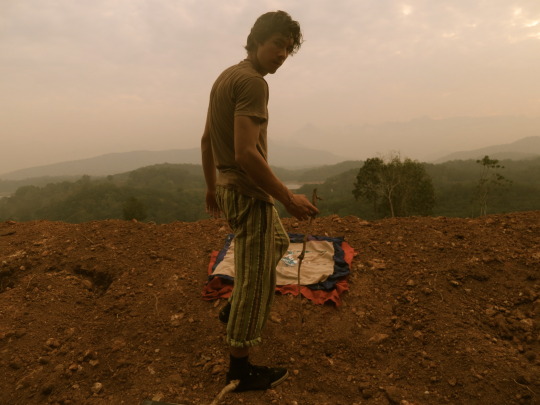
We recently interviewed Swiss-American painter Neil Enggist to talk about his life, work and how he is coping with self-isolation. Neil’s exhibition The Practice of the Wild was supposed to open at the Consulate General of Switzerland in New York last month as the 8th edition of Art@The Consulate but was postponed due to COVID-19.
Hi Neil, thank you for taking the time to talk to us. Where are you right now? It is my pleasure. I’m in New Jersey. I have a backyard studio near Princeton, in the old house where I grew up. I’m staying put as much as I can.
Tell us about yourself, where did you grow up? My mother is from Taiwan and my father was born and raised in Luzern, both coming for graduate studies in 1969 to Buffalo. I was born and raised in Princeton Junction in an old stone house near a small forest and the train station. My father was teaching in the Bronx and Connecticut, then trying his hand at importing Swiss Chocolate, but at some point in the 1970s, he turned to stained glass. I remember him cutting, wrapping, and soldering in the backyard. My mother worked for the state of NJ, and drew from the model in her spare time. I drew dinosaurs like a maniac, not very well I may add, but at some point around age 7, my father asked me to draw a dinosaur that he made into a stained glass panel. As a family we traveled to Luzern about every 2 years, and I still remember the smell of Birenwecken and lightning over the Vierwaldstättersee. I drew all the time but wasn’t precocious, as a youth, I was shy, quiet, hot tempered, diligent with school, perfectionist, and mostly played soccer and saxophone and you know, did my math homework.
When did you know you wanted to become an artist? I went to art school at Washington University in 2000, but it wasn’t until studying abroad in Florence in 02 that I had the feel of becoming an artist. There is a laminated portrait from first grade, age 6, where I put into writing that I wanted to be an ‘Artist.’ But in Florence my life felt like it shifted from art student to artist, 3 dear friends and I shared an apartment on Piazza Independenza, learning photography, printmaking, illustration, bookmaking, Italian and art history at a tiny art school called Santa Reparata. My future Love lived up the street and sometimes the cheap red wine would flow. Behind every door were Renaissance frescos, leaping off the walls were Donatellos, and it was the beginning of my explorations as a painter. I would paint plein-air small landscapes and cityscapes with oils, but by the end my ambition grew into a very large Kandinskyesque abstract rendition of Michelangelo’s Final Judgment fresco from the Sistine wall. A year later, back in St. Louis I declared painting as my major, and in the words of Joe Campbell, began ‘following my bliss.’
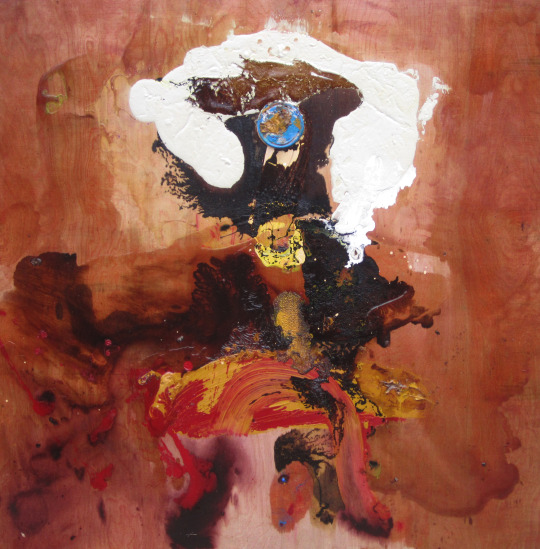
Neil Enggist, Sea on Earth, acrylic and stain on wood, 2011
How would you describe your style? Has it changed over the years? I would say it’s an Organic Abstract Expressionism, or Nature Action Painting. Over nearly 20 years, YES it has changed! Like a photon going from point A, painting the Ponte Vecchio, to B, dancing on a piece of steel with turmeric and ocean water, taking every single possible path! To say it’s moved linearly would be wrong, but there is a sequence of transformations or leaps, in the Ozarks, Mysticism, Heartbreak, Dylan, New Mexico, Traveling Europe, The Mir, snow painting, India, Brooklyn, Voice and Veil, Gardening, going cross county, yoga, India again, the dance, steel, the tides, The Tao and the Yellow Mountains, devotion. I’m very interested how Dylan’s work has transformed and shifted, beyond expectation, without calculation, yet somehow almost always in line with his poetic essence. My paintings have changed like dinosaurs and birds, from a common source, many branches, some seemingly from different worlds, some becoming bones and fossils, some soaring through the sky.
Tell us about your artistic practice, where do you paint, what inspires you? Well we can start with Highway 61.. music of the American vernacular, jazz, blues, country, rock, folk, hip hop.. from Louis Armstrong, Strange Fruit, Charlie Parker, to the early Bluesmen of the Mississippi Delta, Robert Johnson, folksingers like Woody Guthrie, onwards and outwards to Wutang and Nas. Basquiat inspires me. Ana Medieta, DeKooning, Paul Klee, David Hammons, Polke, Mel Chin, James Turrell, Richard Long, Kerry James, Doig, Ofili, Wangechi Mutu, John Akomfrah, Bonnard, Matisse, Puryear too. Gary Snyder's brilliant collection of essays 'The Practice of the Wild,' from where the title of the exhibition comes, has helped me attune to the wild systems at play in nature and within, and continues to evolve my way of thinking, seeing, and creative being. Taking a journey into nature, not just a dip into nature, but really feeling the connections, the web that runs through the forest and is woven into your own nature. The Redwoods, the Swiss Alps, the Coast of California.. I lose and become myself here. In my practice, nature is welcomed into the process of artistic creation. The imagined line between artistic intention and the creative functioning of wilderness is blurred, or more accurately, these spheres merge into a unified moment. It’s a spiritual practice, a kind of Taoist exercise, merging with the changes of the natural world, not holding, not fixing, listening to what the painting wants to become, and finding the color to enable the beholding. I paint outside and on the road, sometimes inside.. anywhere..
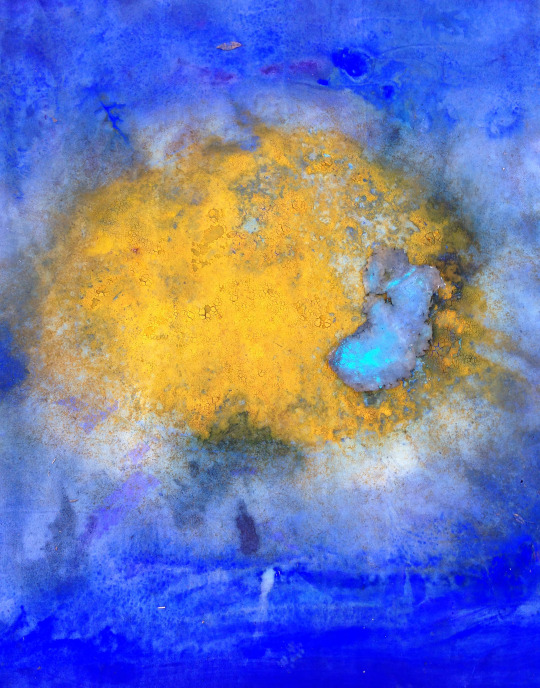
Neil Enggist, Odyssey III, acrylic, dye and turmeric on canvas, 2020
What role does Switzerland play in your life/art? My family has a house in Luzern, with a balcony opening to a view of Mount Pilatus that I would call perfect.. at least on the days where it’s not obscured by Nebel! Since 2012, I’ve been spending many springs / summers living there, in the bohemian remodeling of our chalet attic called the Macolette. I have painted and drawn our view of Pilatus so many times, it is ingrained in my mind’s eye. I’ve explored and hiked the mountains surrounding the Vierwaldstättersee, Grindelwald, Engadin, and Zermatt, finding places on and off the path to paint. When I am in the mountains, alone with my pack, in the quietude and breathtaking beauty, I feel something akin to being home, being one with myself, being on my true path. This feeling is fleeting and eternal. Also, during many of the summers, I have worked with my great friend and mentor, garden designer, Andre Ammann, constructing and maintaining gardens around Luzern. Working with him has taught me in so many ways, to notice the minute changes of spring, to work with contrasts of nature and culture, to understand placement of boulders and trees, how to create a riverscape, to dissolve into the consciousness of the river. When we are done with the work, all cleaned, raked, and hosed down, Andre and I look at our work, and he’ll say, ‘Now, the garden starts, try to see how this will look in 10 years, in 50 years..’ This has been a major influence in my own ‘Practice of the Wild’ and painting. It has also taught me how to shovel!
You have traveled all over the world, how has the nomad life shaped your art? As a traveler, painting becomes the act of experiencing and processing place; the painting becomes an archive of experience. Traveling serves to connect the painter with the uncomfortable and uncalculated, which forces a spontaneity and body-memory response. I aim to paint as one would do battle and dance and play jazz at once. In traveling, the painter becomes the abstraction, inhabiting transient and visionary territory. Materials from places of special significance, white gypsum sand from New Mexico, pigment from the Holi festival of India, black sand from Kanyakumari, gravel from Highway 61, layer into the topography, giving the painting a personal geographic context, while opening formal and textural possibilities. On the road, I explore the spiritual territory of color, and natural occurrences of unearthly blues.
With the COVID-19 pandemic, travel is no longer possible, in what ways has the pandemic shaped your practice / life? I just drove from California to NY in 5 days to install the Consulate show, just before the Covid situation hit the fan. I am supposed to be in India right now, doing a residency in the Himalayas! I’ve had a number of shows postponed and it just really doesn’t seem like people are buying many paintings right now.. But, really compared to people who are sick, caring for loved ones, and risking their lives to care for others, my sacrifices are minuscule. And I can most surely still paint! But I’m trying to use this time to do things I would have done in ‘normal’ times, but there are no normal times anymore. I’ve been making sculptures out of half rotten wood using an ax and a handsaw. I’ve been learning some Tai Chi from my Ma. I’ve started reading the Mahabharata. I’ve been texting whole a lot of hearts to California and writing love songs, and staying out of the bar..
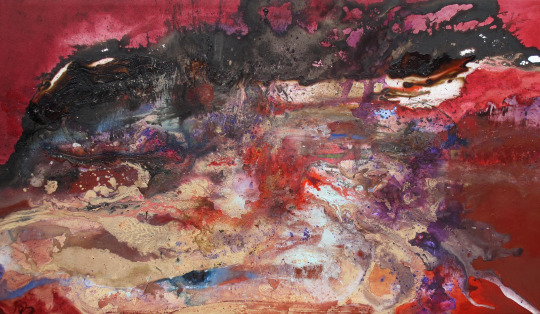
Neil Enggist, That Great Mysterious Storm, acrylic, ink, oil and sand on canvas, 2010
What important lessons do you think we can learn from the impact of the pandemic? Well, first and foremost gratitude for life, health, and for the things that we used to take for granted. To be grateful for the people who are dear to us. This may sound cliché, but the pandemic has shown us how connected we are, for better and for worse. We are interdependent, and what affects one region affects the global community. I hope that people can stop and reassess their personal and collective relationship with the planet. In a profound and dire way, humans and our socio-economic systems have entered an unbalanced, virus-like relationship with this Earth. Humans seem to need wake up calls to affect changes, I hope this pandemic serves as a paradigm shift for enough of us. We are in this together. Yes when this is over, it will be great to go to a yoga class, an Indian restaurant, and to toast with friends, but we each need to use this time to reaffirm our commitments to each other and to all beings of this planet, and not go back to business as usual.
What advice do you have for people stuck at home? Can you recommend something to read, listen or watch? Well I’m a Liverpool fan, and we were just about to WIN the premier league, so I’ve had to go back and watch Liverpool highlights to cope. There’s a lovely interview with the legendary skipper Steven Gerrard in conversation with Gary Neville on youtube. I’m a very lazy television watcher, meaning I don’t really watch new things, so it’s The Sopranos, and very little else. Peaky Blinders is good, violent, but solid. Kurosawa’s ‘Dreams’ is a ravishing movie. I just saw ‘Purple Rain’ again, EPIC. When I drove across country I listened to Toni Morrison’s own reading of her novel ‘A Mercy,’ and it took my breath away, literally every sentence .. I don’t know how I even made it! She’s a true master in telling a harrowing story in pure poetry. Also reading ‘An Indigenous People’s History of the United States’ and Leonard Peltier’s ‘Prison Writings.’ Musically I needed a lil rock, so I went back to the Black Keys ‘Brothers’, Brittany Howard’s solo ‘Jaime’ is good, JS Ondara, Black Pumas, Valerie June’s ‘Love Told a Lie,’ AM!R’s ‘Parachute, ‘ and the syrupy ‘Cigarettes after Sex.’ I’ve been listening as well to Gann Brewer’s most recent ‘Absolution.’ I made the video for his ‘River Song.’ Tracy Chapman’s first album is incredible. Springsteen’s ‘The River’ is like his White Album and sometimes I need to hear the Boss sing ‘Heart and Soul’ over and over.. and hear that ‘Drive All Night’ sax solo by the late great Clarence Clemons. I am from Jersey, don’t forget. Listening to a lot of John Prine too, and with his recent passing, his music shines like a diamond ring. ‘Christmas in Prison’ is one of my favorites of many. Oh and Bob Dylan just released a 17 minute song about the assassination of JFK, and it’s .. indescribable.
Thank you Neil!
To find out more about Neil Enggist go to www.neilenggist.com, contact Neil at [email protected] and follow him @neilenggist
Scroll down for more information about the exhibition The Practice of the Wild which will open to the public as soon as it is safe to do so. Please note that all paintings depicted in this article are featured in the exhibition.
NEIL ENGGIST
THE PRACTICE OF THE WILD
8TH EDITION OF ART@THE CONSULATE
THE PRACTICE OF THE WILD by Swiss-American painter Neil Enggist is comprised of a series of abstract mixed media Nature Action Paintings, a method by which nature performs an integral part in the artistic process.
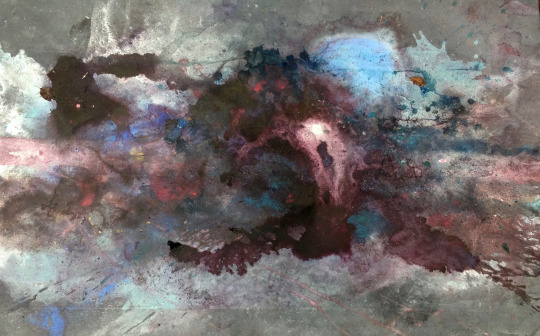
Neil Enggist, The Storm Ends, acrylic, ink, dye and sand on canvas, 2019
“My work seeks to embody the random precision through which life and spirit intersect. Within a liminal environment, I present set of conditions where the form can be born through an unfolding of natural currents. The nature of water, marks of evaporation, melting, freezing, burning, gravity, animal tracks, traces of dance, time, storms, tides and all manner of seasonal and emotional weather coincide to transform the canvas into a terrain in flux. Whether I am dripping ink into a melting tuft of snow, pouring the ocean on burning ink, or slashing the surface with a fallen pine branch, each action is composed within a system of nature. The result is a site of becoming where oceanic, emotive, and mystical stories interplay”
Raised in Princeton, New Jersey, Neil Enggist studied fine arts at Washington University in St. Louis and Santa Reparata in Florence. He earned his MFA at San Francisco Art Institute in 2016 where he made paintings on steel in the tidal zones of the Bay Area, searching for a language between art and nature, incorporating ideas of performance and sculpture imbedded in the earth art movement. Enggist has participated in a number of art residencies including the Lucid Art Foundation in Point Reyes, CA, and most recently journeyed to the land of his grandmother to paint the City of Shanghai and the Yellow Mountains of China. Through his extensive travels in Europe, the Americas, and Asia he developed a body of painting and poetry shown in New York, Milan, Mumbai, Luzern, and Paris. Enggist lives and works between New York and Luzern, Switzerland.
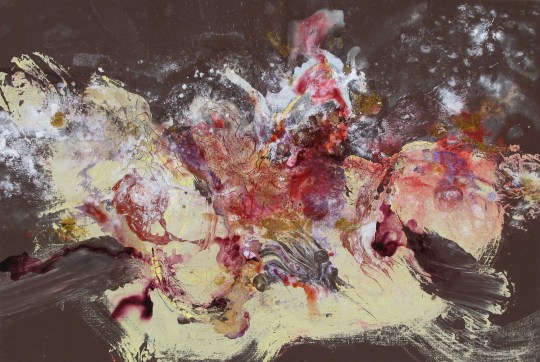
Neil Enggist, The Schreckhorn, acrylic, ink, pigment and oil on canvas, 2007
THE PRACTICE OF THE WILD is the eighth edition of Art @ The Consulate, a curatorial initiative by the Consulate General of Switzerland in New York to showcase the work of Swiss artists living in the United States. Follow Art @ The Consulate on Social media #SwissArtNYC
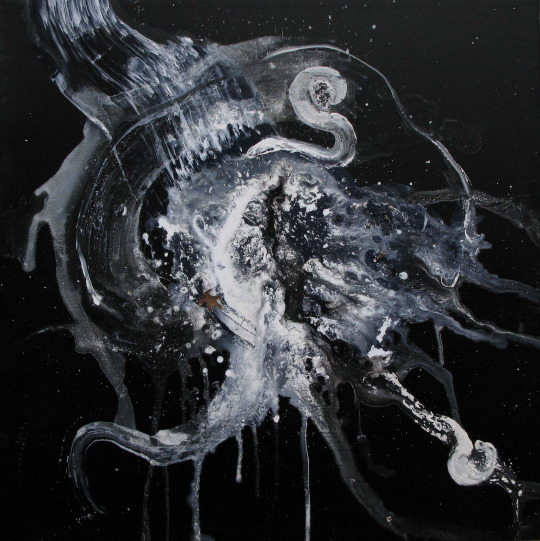
Neil Enggist, A Candle Burns at Night, Acrylic and ink on canvas, 2008
2 notes
·
View notes
Text
Finding Home - Ch. 2
Summary: They only see each other once every few months, but this time he wants to say good bye forever and she wants him to finally come home. READ PT. 1 HERE
Notes: Bughead AU - This one is sad, I’m so sorry...but stay tuned for Pt. 3 :D
It was the dead of night when the rumble of the motorcycle touched the land he saw as hers and she saw as theirs. The ride from the gate to the house was long enough for him to wonder if they were really in private property at all, it was grand and kept and beautiful, more than he’d ever had- and more than he’d ever have, he reminded himself, straightening a little as they approached the barn first and then, with a path so welcoming it screamed of Betty, the house. Her home.
Jughead parked the motorcycle behind the barn, helping her off of it though she didn’t need it and trying to hide his awe. It was perfect. It was everything they had talked about when they’d dreamt of going to college together, graduating, building a life and a family that would be nothing like either of theirs had been. It had the wrap around porch she’d always wanted to drink lemonade on, the blue shutters Jughead had admitted to wanting one night when it was too late to watch his honesty and keep it in check. The door was heavy wood with a stained glass panel in the colors of the Jones crest, a silly thing they’d shared between kisses and passing notes in class once upon a time. They had been so innocent, even with the murders all around them, they had been so hopeful about having each other forever.
Jughead noticed the letters carved onto the wooden pillars seemingly holding the entrance up, and though he didn’t read them, he knew what they were. “I am going to write you letters on every inch of our house so when you see it, you’ll know I’m waiting.” She had said a decade ago, the first time he’d left, before she had found the land.
“Betty-” His voice broke and she wrapped her arms around him from behind. If this didn’t convince him to stay nothing would and for all the hope and optimism she had for the people in town, she had none for herself because she didn’t deserve the happiness Jughead gave her, that was the only explanation for their not being able to be together in all these years. “Betty I have to-”
“There’s more to see.” she interrupted him and laced her fingers with his, “Let me show you?” She kissed his cheek and held her body close to his trying to memorize what his warmth felt like for cold, winter days, for cold sheets on too big a bed, for reality, when it set in that he was gone and maybe he was doing the same because he nodded.
Betty lead him past the porch and the entrance through a house that was so magnificently representative of them both that it felt familiar, and yet it didn’t hold a single memory of them as children. No hopes gone wrong, no family portraits of abuse, no bad decisions or shed tears. It was all new, ready to have their history written into it without an ounce of regretful past, and yet he knew he couldn’t stay to do that. “It’s nice, Betty.” He managed as his eyes tried to take it all in to remember when he was on the road again. He wanted every detail in his mind, he wanted to remember forever the home that could have been his if only he were someone else. “But Betty, I have to-”
“Go.” She interrupted again, the sorrow in her voice so evident, her heart break so honest that the guilt in him consumed him. He almost slipped, he almost apologized but he didn’t because he didn’t want her to forgive him, he wanted her to hate him and move on and be happy, even if he knew that the words he hadn’t spoken back in nearly a decade were still true and would always stay that way. He loved her, he had no doubts about that. “I know.” She kept pulling him up the stairs, looking forward and avoiding his eyes.
There were frames on the wall, but instead of pictures there were simple white pages in her pretty script that read “Our wedding day” and “Our first child” and “our first family portrait”. They went on and on all the way to “Our little girl’s first day of school” then they were empty. As if sensing what he was noticing she explained, “I write them when I imagine those things should have happened. Maybe one day I can put pictures in them.” her tone was hollow, they both knew that wouldn’t happen. Even if they somehow managed to be together, having a child was simply too dangerous.
“Betty, I have to go.” His heart was breaking but they were at the top of the stairs now and he could see several closed doors with small rectangular chalk board name plates hanging from each. “Guests”, “Mr. & Mrs.”, “Our Little Boy”, “Our Little Girl”. He was close to tears and he pulled his hand from hers, ready to turn and go and tell himself he would never look back, but then she turned to meet his eyes.
“I know you’re leaving.” She said, not bothering to hide the tears in her eyes, “Can you make love to me in our bed? Just once?” a tear fell so perfectly from her eye that it barely graced her cheek and landed on her chest. She would never admit it, not to him or anyone, but she hadn’t spent a single night in that bedroom, that was reserved for them as a pair. a whole. For now, she was a guest in her own house. Jughead didn’t question it. He just nodded once, he thought his voice would betray him if he tried to say anything at all and really, it was a very poetic end to their otherwise chaotic story.
The room, just like the rest of the house was perfect. It was decorated in muted tones and had a balcony looking over acres of trees, not a house in sight. The dresser had their initials and the canvas over their bed was a simple black and white blueprint of the place that could have been their home in another life time. Words would have ruined the moment so he caressed her cheek and pulled her into a soft kiss that held all the hesitation only a man convincing himself to leave love behind could feel. Again, he wanted to apologize but didn’t.
Jughead used calloused fingers to move up her arms, helping the spaghetti straps of her pretty dress fall off her shoulders so the dress fell on the floor. He took off his shirt in a quick, fluid movement and kissed her forehead, her cheek, her shoulder. He was saying goodbye to every single part of her, his hands on her waist, holding her as if he was scared she’d disappear knowing he was the one in that magic act. In turn, she moved his curls away from his eyes, needing to look at him, she let her hands travel down his front and his back caressing him, memorizing his skin, scars and all. This was torture for both of them.
They took all the time in the world to touch each other, to make each other sigh and arch and whine. They kissed until their lips were numb and swollen and when even when they were done, they kept touching. Eventually, the sun came up and they fell asleep wrapped around each other, begging time to stop and let them stay like this forever. They never spoke a word, they never said good bye.
When Betty woke, she was alone and on her night stand sat a note “I hope you never forgive me. I love you.” She curled up in a tiny ball on the bed, far too big for one and for once, let herself fall into pieces.
#solo#jughead x betty#jughead x betty fanfiction#jughead x betty fanfic#betty x jughead#betty x jughead fanfiction#betty x jughead fanfic#bughead#bughead fanfiction#bughead fanfic#jughead and betty#jughead and betty fanfiction#jughead and betty fanfic#betty and jughead#betty and jughead fanfiction#betty and jughead fanfic#riverdale#riverdale fanfiction#riverdale fanfic
6 notes
·
View notes
Text
01 July 2017
I just finished reading One Hundred Years of Solitude for the second time. It's a hot day in Chicago and the edge of the circle of time is so sharp.
I decided that I should try to see all 50 major museums here in Chicago before I leave, so yesterday I went out on the Brown line & transferred to the Red line in order to get to the Chicago station. There, I had a Potbelly sandwich and talked to Aidan for a little while before heading to the first museum: the Loyola University Art Museum, which turned out to be a very Catholic museum full of religious artifacts from the middle ages/Renaissance era, mostly. There were relics, the bones of saints, in some of the pieces--there were silver chalices from Germany in the 1700s and Roman keys from the first century BC and paintings by students of Caravaggio and stone apostles defaced during the Reformation. One of the hallways was full of self-portraits done by member of a poor community somewhere in Chicago, just pencil sketches that mostly looked as if they were done by children but were probably done by adults who never had the time or resources to fool around with artistic experiments. I tried to read all of the little museum information signs but at some point I got overwhelmed by the religious imagery and simply took it in aesthetically. There were two stained-glass windows done mostly in gray with bright yellow shading as the only color that I probably liked the best. A display of keys from the copper ones of the Roman empire through to the iron ones of the Middle Ages and steel ones of the Renaissance was also really striking. I like that they all did the same things but in slightly different ways, that they were all so neat and precise in their designs--one even had a club shape as the barrel of the key, or whatever it's called. It was really empty, I only saw maybe one or two other people apart from the staff (college-aged girls in blue shirts and black pants) who gossiped with one another while I walked through the museum.
The Museum of Contemporary Art was only a block away, and was the real object of my day, so I went over there and paid the $8 entrance using my JNU student ID that expired last month. Lots of young people sat on the steps leading up to the entrance and the windows above were adorned with a giant tentacle motif in homage to the Murakami exhibition on the third floor. The first floor had two exhibitions, ETERNAL YOUTH and SMOKE, RISES or something; the first was nostalgic somehow, with magazine prints of Marky Mark and Kate Moss in Calvin Klein ads, an Instagram model blown up to be life-sized, and some other not-so-surprising or provocative looks at youth; it's not surprising anymore, to see kids wrecked by drugs or hiding behind masks or struggling with the trials of adolescence; we're so oversaturated with such content these days, it felt like a somewhat lazy exhibition--I did find some of the text pieces interesting, talking about the commodification of youth and how it's used as an empty promise and vague reason to buy something.
The other, across the hall, was a series of basic sculptures involving 'other people' outside of the exhibition somehow, outside of the museum. Marble sculptures with shallow pools containing contact lenses of people who didn't know one another, SIM cards in cement blocks, manipulated window panes folded in strange shapes with cigarette buts or guitar strings attached to them. The most provocative one, to me, was a 'wall' with a square canvases on either side painted in the pattern of a shirt and a dress worn by a man and a woman who would occasionally come to the museum; the might meet, they might not; the canvases were put on parallel tracks that ran the length of the wall. And then a metal rod with a single earring through it--the other is presently worn by a woman somewhere in the world, which is the complementary part of the sculpture. The artist invites you to imagine the human elements that are contained in-part, yet that ultimately transcend, the museum space and sculpture itself. I found myself wanting more of that one, I felt that it was real art that provoked something in the viewer, a creative act that was the same and different every time.
There was another gallery on that floor, tucked in the corner--a series of made-up constellations was on one wall, understandably meditating on the arbitrary yet meaningful nature of any constellation in the night sky that we have come to identify. The exhibit was named after some part of Moby Dick, 'the shallow level' or something like that. From Ahab's quotation about needing to strike through the mask, about how there is something beyond us that we can't quite access. Though the written explanation of the intention excited me tremendously, I found the art to be somewhat lacking, probably just because it's not to my taste. A painting that was overlaid with pink paint such that you can still kind-of see the stuff beneath (really obvious relevance, not profoundly interesting), a set of concrete blocks that looks solid from 3/4 sides but opens on the other, a map written over with a poem by the artist about metaphor and perception and imagining an analogous human example of reducing the world to a map, which I liked best, and some other things that didn't strike me particularly.
Upstairs was an installation that I really hated with some computer-generated supermarket images of fruit and weird grocery store dollies and something about trying to make you feel like you're inside of a freezer with bags of fake ice and all that. Then things that look like paint cans but are actually meticulously crafted wooden sculptures of paint cans. The only part I liked, which was small, was built into the wall; a supposed massage parlor--you can see the entry with the sign, a stairway up to a door, and a back entrance, all in miniature, through holes in the wall. Playing the voyeur with nothing to see, sparking a curiosity that exists but can't exist there.
On the third floor was the Murakami exhibition, which I didn't expect to love so much. The wall was covered in silver and electric pink, tentacles patterns and a stylized 'MURAKAMI.' Some of his beautiful early works with a traditional Japanese artistic technique that depicted turtles that seemed to have been made of condensed and reptilian mystery. A massive blue wall of many panels and absurdly deep blue pigments, an ornate stage setting with 2/1 at the top to celebrate the artist's birthday by making fun of that one guy who only made art that was the date written out on a canvas. More of those mocking types except the date and the canvas were painted the same color so it can hardly be distinguished. And then some rooms on Mr. DOB, his mouse-thing, that I liked sometimes but mostly didn't. Some explanation of his workshop technique making his larger pieces was also featured, but I wasn't too interested in seeing how the magic is made, but rather in the magic itself. His 'superflat' pieces were really compelling--flowers with faces covering an entire wall, for instance--and his aesthetic came back to me from his various famous collaborations with people in the 2000s, especially. None of that stuff was really my thing, but the rigorous detail impressed me. It started to get really exciting for me upon seeing Kanye's Graduation album cover in real life, in addition to a sculpture of the Kanye Bear and another painting from that time-period. A grandmother was trying to explain to her grandkids who Kanye West was--'a very famous rapper' and I found it funny.
The room that made me feel the most, though, was a huge rectangular gallery with two massive sculptures of demons or something, red and blue, at the entrance and exit of the room, with some Murakami stained-glass windows behind them in a sort of religious allusion. The long walls were covered by two pieces--one was a white and blue dragon that didn't captivate me terribly much, but the other was a huge, intricate, and profoundly striking work of 100 monks of various sizes, stylized and detailed in the most precise and stunning manner. It was both grotesque and ascetic, simultaneously religious and irreverent. The size of everything was really moving to me.
The final room displayed Murakami's most recent piece, done especially for the exhibition, entitled 'the octopus eats its own tentacle' or something like that. It's a reference to a Japanese saying that deals with cutting off an arm in order to grow a new one, with the recycling of the past and the coming of a circular future. That one was also beautiful, though I had been too impressed by the previous room to feel anything but a visual hangover as I pondered the equally beautiful scene.
I left looking for a place to read and enjoy something to drink while listening to Vince Staples' new album, which I was inspired to hear because the museum is having him speak there later this month. I really liked what I heard and keep meaning to peruse it further. I ended up at a little French bistro where I had some happy-hour red wine that I had missed. Red wine was plentiful in Argentina, but I was very deprived of it in India, so it felt like a revelation. I read my book, talked to my sister and parents, and then ordered some muscles around sunset. They were gorgeous; I had smelled them from another table earlier in the evening and resolved to try them despite my ongoing attempts at vegetarianism (currently, I've decided to eat meat only one day per week). And it really was a beautiful day, I couldn't have asked for anything better. Solitude isn't necessarily that bad.
1 note
·
View note